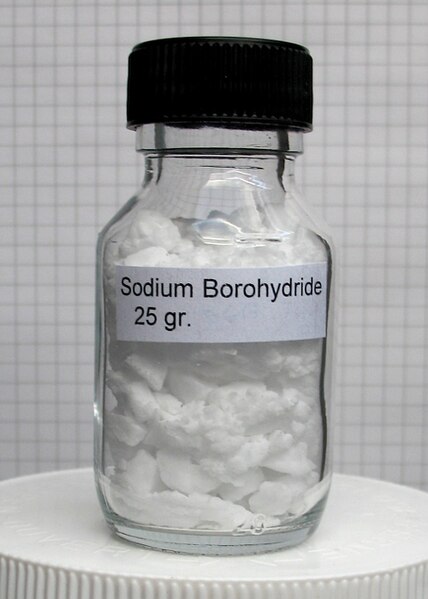Sodium borohydride, also known as sodium tetrahydridoborate, and sodium tetrahydroborate is an inorganic compound with the formula NaBH4. This white solid, usually encountered as a powder, is a versatile reducing agent that finds wide application in chemistry, both in the laboratory and on a technical scale. Large amounts are used for bleaching wood pulp. The compound is soluble in alcohols and certain ethers but reacts with water in the absence of a base.
The compound was discovered in the 1940s by H. I. Schlesinger, who led a team that developed metal borohydrides for wartime applications (in particular, looking for a uranium compound more volatile than the hexafluoride to be used in isotope separation by gaseous diffusion; this line of research did not pan out). Their work was declassified and published only in 1953.
Properties
Sodium borohydride is an odorless white to gray-white microcrystalline powder which often forms lumps. It can be purified by recrystallization from warm (50 °C) diglyme. Sodium borohydride is soluble in protic solvents such as water and lower alcohols; it will also react with these solvents to produce H2; however, these reactions are fairly slow. Complete decomposition in excess methanol can take nearly 90 min at 20 °C. It will decompose in neutral or acidic aqueous solutions but is stable at pH 14. These conditions can be exploited to allow sodium borohydride to react in a homogeneous manner, with reduced lifespan being traded against increased reactivity.
Structure
NaBH4 is a salt, consisting of the tetrahedral BH4âˆ' anion. The solid is known to exist as three polymorphs: α, β and γ. The stable phase at room temperature and pressure is α-NaBH4, which is cubic and adopts an NaCl-type structure, in the Fm3m space group. At a pressure of 6.3 GPa, the structure changes to the tetragonal β-NaBH4 (space group P421c) and at 8.9 GPa, the orthorhombic γ-NaBH4 (space group Pnma) becomes the most stable.
Synthesis and handling

Sodium borohydride is prepared industrially following the original method of Schlesinger: sodium hydride is treated with trimethyl borate at 250â€"270 °C:
- B(OCH3)3 + 4 NaH â†' NaBH4 + 3 NaOCH3
Millions of kilograms are produced annually, far exceeding the production levels of any other hydride reducing agent. Sodium borohydride can also be produced by the action of NaH on powdered borosilicate glass.
Reactivity

NaBH4 will reduce many organic carbonyls, depending on the precise conditions. Most typically, it is used in the laboratory for converting ketones and aldehydes to alcohols. It will reduce acyl chlorides, thiol esters and imines. Under typical conditions, it will not reduce esters, amides, or carboxylic acids. At room temperature, the only acid derivatives it reduces are acyl chlorides, which are exceptionally electrophilic.
Many other hydride reagents are more strongly reducing. These usually involve replacing hydride with alkyl groups, such as lithium triethylborohydride and L-Selectride (lithium tri-sec-butylborohydride), or replacing B with Al. Variations in the counterion also affect the reactivity of the borohydride.
The reactivity of NaBH4 can be enhanced or augmented by a variety of compounds. Oxidation with iodine in tetrahydrofuran gives the BH3-THF complex, which can reduce carboxylic acids. Likewise, the NaBH4-MeOH system, formed by the addition of methanol to sodium borohydride in refluxing THF, reduces esters to the corresponding alcohols. Mixing water or an alcohol with the borohydride converts some of it into unstable hydride ester, which is more efficient at reduction, but the reductant will eventually decompose spontaneously to give hydrogen gas and borates. The same reaction can run also intramolecularly: an α-ketoester converts into a diol, since the alcohol produced will attack the borohydride to produce an ester of the borohydride, which then reduces the neighboring ester. The combination of NaBH4 with carboxylic acids results in the formation of acyloxyborohydride species. These can perform a variety of reductions not normally associated with borohydride chemistry, such as alcohols to hydrocarbons and nitriles to primary amines.
Coordination chemistry
BH4âˆ' is a ligand for metal ions. Such borohydride complexes are often prepared by the action of NaBH4 (or the LiBH4) on the corresponding metal halide. One example is the titanocene derivative:
- 2 (C5H5)2TiCl2 + 4 NaBH4 â†' 2 (C5H5)2TiBH4 + 4 NaCl + B2H6 + H2
Hydrogen source
In the presence of metal catalysts, sodium borohydride releases hydrogen. Exploiting this reactivity, sodium borohydride is used in prototypes of the direct borohydride fuel cell. The hydrogen is generated for a fuel cell by catalytic decomposition of the aqueous borohydride solution:
- NaBH4 + 2 H2O â†' NaBO2 + 4 H2 (Î"H < 0)
Applications
The principal application of sodium borohydride is the production of sodium dithionite from sulfur dioxide: Sodium dithionite is used as a bleaching agent for wood pulp and in the dyeing industry.
Sodium borohydride reduces aldehydes and ketones to give the related alcohols. This reaction is used in the production of various antibiotics including chloramphenicol, dihydrostreptomycin, and thiophenicol. Various steroids and vitamin A are prepared using sodium borohydride in at least one step.
Sodium borohydride is used as reducing agent in the synthesis of gold nanoparticles.
Sodium borohydride has been considered as a solid state hydrogen storage candidate. Although practical temperatures and pressures for hydrogen storage have not been achieved, in 2012 a coreâ€"shell nanostructure of sodium borohydride was used successfully to store, release and reabsorb hydrogen under moderate conditions.
Safety
Sodium borohydride is a source of basic borate salts which can be corrosive, and hydrogen or diborane, which are both flammable. Spontaneous ignition can result from solution of sodium borohydride in dimethylformamide.
In Art
- in xkcd.com comic strip
See also
- Lithium borohydride
- Lithium aluminium hydride
- Diisobutylaluminium hydride
References
External links
- National Pollutant Inventory â€" Boron and compounds
- MSDS for Sodium Borohydride
- Materials & Energy Research Institute Tokyo, Ltd.
- Chemo- and stereoselectivity using Borohydride reagents
- Material Safety Data Sheet




It is a very informative and useful post thanks it is good material to read this post increases my knowledge. SODIUM TRIACETOXY BOROHYDRIDE
BalasHapus